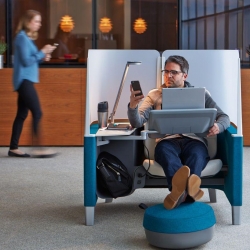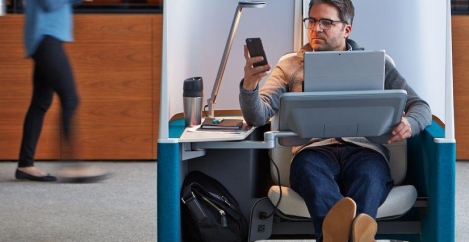January 14, 2020
Office design in the US now more closely aligned with needs of workers
 Office design and expectations around professionalism in the workplace are evolving along with the modern workforce in America, according to a new report from researchers at Olivet Nazarene University. The Modern Office Study claims that office design is evolving in parallel with changes in working culture, especially in the way that traditional North American cubicles, which were once the default model of office design in the US, are rapidly being replaced with open plan layouts. The report claims that these are now found in over half of American workplaces.
Office design and expectations around professionalism in the workplace are evolving along with the modern workforce in America, according to a new report from researchers at Olivet Nazarene University. The Modern Office Study claims that office design is evolving in parallel with changes in working culture, especially in the way that traditional North American cubicles, which were once the default model of office design in the US, are rapidly being replaced with open plan layouts. The report claims that these are now found in over half of American workplaces.
The researchers argue that although the uptake of open plan layouts remain controversial, business owners are in fact focusing primarily on the employees needs and wants first and foremost when they introduce new office design models and working cultures.
The report is based on a survey of over 2,000 American workers and set out to learn about their current office environment and how it impacts their levels of both productivity and happiness at work. The study asked about modern office layouts, happiness levels at work, employee productivity, digital distractions and how workers cope, messaging apps at work and working from home.
Key findings:
- The study found that 77 percent of American workers said they are currently happy with the way their office is setup with those in private offices saying they are the happiest at work. Open floor plans have replaced Cubicles as the most popular type of workplace layout. Open floor plans can now be found in over 51 percent of workplaces today.
- Employee productivity at work is always a popular and controversial topic. 67 percent of respondents said they are currently as productive as they can be in their current office layout. Those with private offices reported the highest levels of productivity with those in cubicles reporting the lowest levels of productivity. With those numbers it should surprise no one to see cubicles being replaced at such rapid rates.
- When it comes to dealing with digital distractions while at work, over half of all workers (53 percent) said they use headphones to deal with noise in the office. Also, thanks to technology, American employees say they know have more daily conversations via messaging apps than they do in person.
The last part of the study covers working from home. 58 percent of workers say that they are less productive when working from home. They also reported dressing more much casually when working from home. The top reasons for loss of productivity include digital distractions, difficulty communicating and collaborating with colleagues as well as trouble knowing when to sign off at the end of the day.













